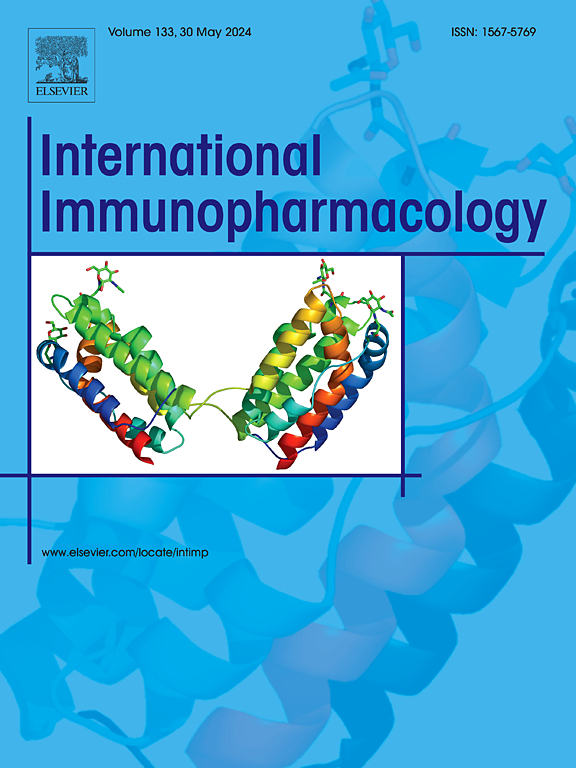The natural compound PEITC ameliorates imiquimod-induced psoriasis in mice by suppressing neutrophil extracellular traps formation
IF 4.8
2区 医学
Q2 IMMUNOLOGY
引用次数: 0
Abstract
Neutrophil extracellular traps (NETs) play a key role in the development of psoriasis, a chronic inflammatory skin condition. We demonstrate the effects and possible mechanisms of phenethyl isothiocyanate (PEITC) in inhibiting NETs and alleviating psoriasis. In response to imiquimod (IMQ), multiple symptoms including scaly plaques and associated skin inflammations were induced in mice. IMQ additionally promotes the formation of NETs and the levels of inflammatory factors. Interestingly, a natural compound PEITC exerted an intensive activity in the treatment of psoriasis. It improved lesions and ameliorated ischemic coagulation symptoms in the dorsal skin of mice. PEITC also significantly reduced the expression of inflammatory factors in mice skin with an inhibition on NETs-related molecules, such as myeloperoxidase, neutrophil elastase and citrullinated histone H3. 16S rRNA sequencing analysis demonstrated that IMQ treatment induced significant gut microbiota dysbiosis in mice, suggesting potential detrimental effects on intestinal microbial homeostasis. However, PEITC administration did not show a statistically significant ameliorative effect on this IMQ-induced microbial imbalance. In vitro experiments demonstrated that PEITC significantly suppressed lipopolysaccharide (LPS)-induced NET formation, suggesting that its therapeutic effects in psoriasis may be due to the inhibition of bacterially driven neutrophil activation. Therefore, we identified PAD4, an important enzyme for post-translational modification of proteins in the production of NETs, as a new potential target of PEITC. Taken together, our findings suggest that PEITC could be a novel potential therapeutic drug to relieve psoriasis via the inhibition of NETs both in vitro and in vivo.
天然化合物PEITC通过抑制中性粒细胞胞外陷阱的形成来改善吡喹莫德诱导的小鼠牛皮癣
中性粒细胞胞外陷阱(NETs)在牛皮癣(一种慢性炎症性皮肤状况)的发展中起关键作用。我们展示了异硫氰酸苯乙酯(PEITC)在抑制NETs和缓解牛皮癣中的作用和可能的机制。咪喹莫特(IMQ)在小鼠中引起多种症状,包括鳞状斑块和相关的皮肤炎症。IMQ还促进NETs的形成和炎症因子的水平。有趣的是,一种天然化合物PEITC在治疗牛皮癣中发挥了强烈的活性。它能改善小鼠背侧皮肤的病变和缺血性凝血症状。PEITC还通过抑制nets相关分子,如髓过氧化物酶、中性粒细胞弹性酶和瓜氨酸组蛋白H3,显著降低小鼠皮肤炎症因子的表达。16S rRNA测序分析表明,IMQ处理导致小鼠肠道微生物群明显失调,提示对肠道微生物稳态有潜在的不利影响。然而,对这种imq诱导的微生物失衡,施用PEITC并没有显示出统计学上显著的改善作用。体外实验表明,PEITC显著抑制脂多糖(LPS)诱导的NET形成,提示其治疗银屑病的作用可能是由于抑制细菌驱动的中性粒细胞活化。因此,我们确定了在NETs产生过程中对蛋白质进行翻译后修饰的重要酶PAD4作为PEITC的一个新的潜在靶点。综上所述,我们的研究结果表明,PEITC可能是一种新的潜在的治疗药物,通过体外和体内抑制NETs来缓解牛皮癣。
本文章由计算机程序翻译,如有差异,请以英文原文为准。
求助全文
约1分钟内获得全文
求助全文
来源期刊
CiteScore
8.40
自引率
3.60%
发文量
935
审稿时长
53 days
期刊介绍:
International Immunopharmacology is the primary vehicle for the publication of original research papers pertinent to the overlapping areas of immunology, pharmacology, cytokine biology, immunotherapy, immunopathology and immunotoxicology. Review articles that encompass these subjects are also welcome.
The subject material appropriate for submission includes:
• Clinical studies employing immunotherapy of any type including the use of: bacterial and chemical agents; thymic hormones, interferon, lymphokines, etc., in transplantation and diseases such as cancer, immunodeficiency, chronic infection and allergic, inflammatory or autoimmune disorders.
• Studies on the mechanisms of action of these agents for specific parameters of immune competence as well as the overall clinical state.
• Pre-clinical animal studies and in vitro studies on mechanisms of action with immunopotentiators, immunomodulators, immunoadjuvants and other pharmacological agents active on cells participating in immune or allergic responses.
• Pharmacological compounds, microbial products and toxicological agents that affect the lymphoid system, and their mechanisms of action.
• Agents that activate genes or modify transcription and translation within the immune response.
• Substances activated, generated, or released through immunologic or related pathways that are pharmacologically active.
• Production, function and regulation of cytokines and their receptors.
• Classical pharmacological studies on the effects of chemokines and bioactive factors released during immunological reactions.

 求助内容:
求助内容: 应助结果提醒方式:
应助结果提醒方式:


